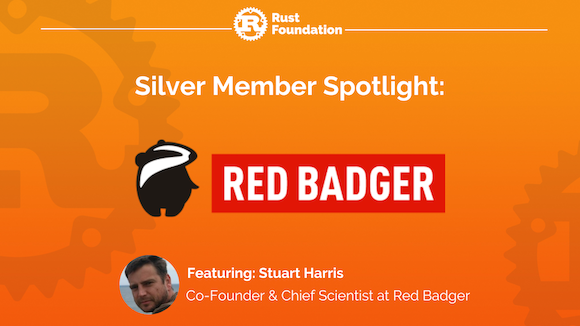
Welcome to another installment of the Rust Foundation Member Spotlight series! These blogs aim to introduce our community to various Rust Foundation Member organizations and their leaders. In this installment, we spoke with Stu Harris, co-founder and Chief Scientist, Red Badger (a Rust Foundation Silver Member organization). Stu chatted with the Rust Foundation team about Red Badger’s mission as a company, how they use Rust, and more.
Tell us about Red Badger. What do you do and who do you serve? #
Red Badger is a digital product consultancy that builds products, platforms, and capabilities in blue chip companies and scale-ups. Places such as big banks (JPMorgan Chase, HSBC, Santander), global media (FT, BBC, Sky, News, Reach), and leading brands (Fortnum's, Selfridges, Nando's, Levi’s). Red Badger builds products and platforms to drive major revenue and business successes for their clients.
How is Red Badger using Rust? #
Red Badger’s clients are often large, complex organizations with swathes of core technologies, some legacy, some modern. Much of their technology is custom-developed and dependent on third parties, with highly integrated and intricate architectures. These organizations are often tackling unique requirements with a desire to innovate their customer, employee, and partner products and services.
Red Badger’s role is to help our enterprise and scale-up clients choose and deploy the best possible technologies for achieving their business goals through digital products, platforms, and capabilities. We help them understand the opportunity of Rust and the most pragmatic routes to adopting it.
Why does Red Badger advocate for Rust so strongly? #
Red Badger has watched Rust emerge from system language-centric applications into many areas of big tech that are developing or refactoring their core tools using Rust. Now, we are seeing an increase in the adoption of Rust as the language of choice for application development. In every dimension that our clients care about (e.g. safety, performance, testability, maintenance, etc.), Rust provides a better answer. For the first time in the history of corporate software, there is no longer a need to pay a performance penalty for the safety required. Before Rust, safe choices were high-level languages and performant ones were low-level; you simply could not have both at once. Rust offers both of these advantages together and we believe this will usher in a new era of enterprise technology patterns and approaches.
Can you give an example of how Rust factors into a typical project with a client? #
One type of project that Red Badger takes on is improving how enterprises commonly support industrial-scale workflows and complex user interactions across many platforms (iOS, Android, web, APIs). User journeys that span different devices, contexts, and services tend to be developed separately and require sizable teams focused on developing specific UX/UI or services.
This means most apps need to be built three times – once for iOS (in Swift), once for Android (in Kotlin), and once for the web (in TypeScript) with no reuse of code, no effort consolidation, and no shared learning. Clearly, there’s no economy in doing the same thing three or more times, and so the industry has been on a years-long hunt for a way of sharing effort and reusing code — a way of building apps just once.
None of the traditional languages or approaches are bad choices, but they have significant downsides. At Red Badger, we think that Rust allows you to build better, mostly because it clarifies which bits are worth sharing and which are not. We believe that sharing behavior as a reusable core written in Rust and wrapped in thin UIs that can be laid out differently on each platform changes everything. Rust offers huge advantages in flexibility, testability, scalability, and resources required.
This approach allows for complex service design to have the logic required to support every possible journey written in a single language. Rust is uniquely positioned to support this approach with its minimal requirements for a runtime environment, making it relatively easy to integrate into all the existing platforms.
All of this is the foundation for our proposed Crux pattern –you can find out more here. We encourage any and all contributions from the Rust community.
Why did Red Badger decide to join the Rust Foundation? #
We are firm believers in open source and in helping enterprises recognize its value. We encourage collaboration and contribution and we have championed open source adoption in enterprises across sectors – and we are active contributors ourselves.
At Red Badger, we see Rust as a language that is on the cusp of enterprise adoption. We believe the advantages Rust provides are irresistible and, therefore, widespread adoption is inevitable. We want to support and contribute to the community and the ecosystem that will ease this transition.
The Rust Foundation provides access to the community and the support, scaffolding, and forum for advancement that we see as critical to adoption in the enterprise. The Foundation helps address so many of the issues we and our clients grapple with every day, so becoming a member made perfect sense.
Stu, what is your personal favorite thing about Rust? #
As an engineer, my favorite thing about Rust is best summed up as “it stops me from shooting myself in the foot.” Before any of the Rust code I write runs, I have high confidence that it is correct. It is hard to make mistakes in the code that a user will find in 6 months’ time, on a Saturday night. This leads to high-quality software as it pushes problems left, where they get highlighted and resolved immediately. This provides an incredible feeling of safety to a developer, especially during refactoring, which we can now do with impunity — helping to keep our software soft, whilst massively reducing the stress involved. The Rust compiler has my back.
What are Red Badger’s hopes for the future of Rust? #
We believe that Rust is a better alternative to many traditional languages out there. We hope and look forward to the ecosystem continuing to mature for adoption across web apps and UX/UI domains. In regard to the language itself, it is already huge. As it continues to evolve, we hope it maintains the principle of greater simplicity and ease of use. Examples of this are already clear in the evolution of Rust (e.g. non-lexical lifetimes) and long may it continue.
At Red Badger, we are very familiar with pioneering new technologies and new approaches in the enterprise – we can see that Rust is already gathering bottom-up momentum. For anyone in business or technical leadership roles, harnessing this momentum with top-down considerations in place will be game-changing. Rust is at an inflection point now and there are no longer advantages in waiting. Those that move quickly now will also accrue the competitive advantage of early knowledge and experience, and attract the best engineering talent.
Stu Harris co-founded Red Badger in 2010 with a firm belief in better ways of doing things. A software engineer in his heart, head, and hands (he still codes), Stu sees how large enterprises and professional services consulting apply technology at scale. Over the last 3 decades, he has been at the center of the agile and digital revolutions and continues to champion better technologies, patterns, and ways of working in enterprises and scale-ups. He believes we’re now entering a sustainability revolution, in which Rust has a key part to play. Stu has been championing its adoption for the last 4 years.
You can follow Red Badger on GitHub, LinkedIn, or Twitter for the latest update.
